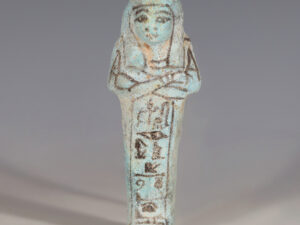Shabtis or ushabtis are among the most numerous of all Egyptian antiquities, as they played a major role in funeral rites. Indeed, they were intended to act as servants for the deceased and to perform any manual labour for their master in the afterlife. For this to be possible, it was necessary that each shabti present in the grave had the name of their master inscribed on it and also a summoning spell to which they replied. In fact, shabti – or ushabti – translates as “the answerer”. Such figurines could also be inscribed with passages from the Book of the Dead, the intention of which was to secure safety for the deceased in the afterlife.
To discover more about Egyptian shabtis, please visit our relevant blog post: How Ancient Egyptian Shabtis and Funerary Statuettes Watched Over the Dead.

















